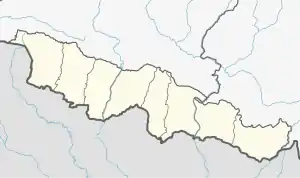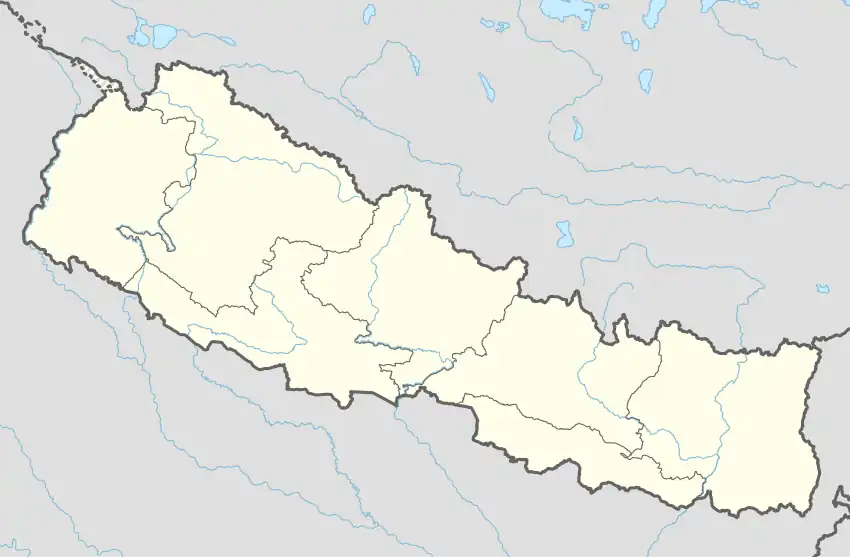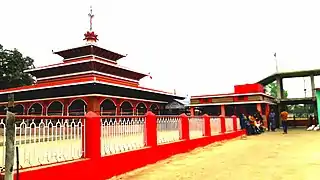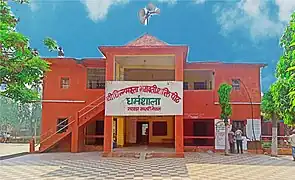| Chinnamasta Bhagawati Temple | |
|---|---|
.JPG.webp) .JPG.webp) From the top down: Goddess statue and full view of Temple from the south direction. | |
| Religion | |
| Affiliation | Hinduism |
| District | Saptari |
| Deity | Chhinnamasta |
| Festivals | Bada Dashain |
| Location | |
| Location | Sakhda, Chhinnamasta |
| State | Madhesh |
| Country | Nepal |
 Chinnamasta Bhagawati Temple in Nepal  Chinnamasta Bhagawati Temple (Nepal) | |
| Geographic coordinates | 26°27′04″N 86°43′52″E / 26.45111°N 86.73111°E |
Chinnamasta Bhagawati also called Shakhada Bhagawati and Shakhadeswori (Nepali: छिन्नमस्ता भगवती) is a temple and Shakti Peethas in Eastern Nepal.[1] It was established in 13th century by Shaktisimhadeva,[2] the fifth ruler of the Karnata dynasty.[3] The temple is in Chhinnamasta Rural Municipality, Saptari, 10 km from Rajbiraj near the Indian border. It is the oldest and most revered religious site in the Saptari district[4][5] and draws thousands of devotees from Nepal and India during Bada Dashain and other festivals to worship the Hindu goddess Bhagawati.[6]
Etymology
The historical name of the temple is Sakhada Bhagawati and the place is known as Sakhada.[7] The name 'Sakhada' is an abbreviation of the last affix of 'Shakra'. The name is derived from the King's nickname, Shakrasimhadeva who is also known as Shaktisimhadeva.[8] In modern times, the temple is known as Chinnamasta because goddess head was missing.[6]
History
In 1097 CE, the Karnat dynasty was established by Nanyadeva in Simraungadh.[9][10] Nanyadeva, who was from Karnata left his state and ran through Pataliputra and came to stay in Bara district of Nepal. He made Nanapura, Champaran as his first capital but later he moved his capital to Simraungadh.[11][12] He was accompanied by lot of his followers including Hindu priests and Kayastha community members.[13] King Nanyadeva's fifth generation descendant was King Shaktisimhadeva aka Shakrasimhadeva (r. 1285 to 1295 CE).[14] He was coup d'état by his general and minister Chadeshwar Thakur with the help of Think-tank council in 1295 CE.[15][16]
After he was dethrone from his supremacy, he came to the present day Saptari district to live the rest of his life in Vaanaprastha (Forest Life) after handing over Kingdom to his younger son Harisimhadeva. Over time, the village was full of jungle. He cleared the dense jungle with his men to build a temple and establish his goddess deity in his name as Sakhreswari. The king's fort was nearby the temple, known as Gadhi Gaachhi locally.[17]
The temple is locally known as Sakhra Bhagawati or Sakhreswari Bhagawati. Since the idol's severed head of the goddess Bhagwati is there, it is known as Chinnamasta Bhagawati.[18]
Invasion
The Tughlaq dynasty ruled the Delhi sultanate and most of Northern India from 1320 to 1413 CE. In 1324 CE, the founder of the dynasty and Sultan of Delhi, Ghiyasuddin Tughlaq turned his attention towards Bengal.[19] They invaded Bengal and on his way back to Delhi, the ruler comes to know about Simraungadh.[20] The Tughlaq armies cross through present-day Saptari to reach Simraungadh, which cause damage of this temple and idol of goddess Bhagawati.[21]
Gallery
 The temple seen from the north gate.
The temple seen from the north gate..jpg.webp) North entrance gate.
North entrance gate. Chinnamasta temple dharmashala.
Chinnamasta temple dharmashala.
References
- ↑ Mecīdekhi mahākālī [Mechi to Mahakali] (in Nepali). Śrī 5 ko Sarakāra Sañcāra Mantrālaya, Sūcanā Vibhāga. 1975. p. 821.
- ↑ Sinha, Dhirendra Narain (2020-09-03). Ganavariyon Ka Itihas Evam Vistara [History and expansion of Ganavariyon] (in Hindi). Dhirendra Narain Sinha. p. 12. ISBN 978-93-5416-423-1.
- ↑ Tripāṭhī, Havaladāra (1977). Bihāra kī nadiyām̐ [Rivers of Bihar] (in Hindi). Bihāra Hindī Grantha Akādamī. p. 377.
- ↑ Abhilekha [Archive] (in Nepali). Śrī 5 ko Sarakāra, Śikshā tathā Saṃskr̥ti Mantrālaya, Purātattva Vibhāga, Rāshṭriya Abhilekhālaya. 1999. p. 22.
- ↑ Dāsa, Harikānta Lāla (2003). Saptarī Jillākā pramukha sāṃskr̥tika sthalaharu: eka adhyayana : laghuanusandhānakārya [Cultural heritage sites of Saptari district] (in Nepali). Nepāla Rājakīya Prajñā-Pratishṭhāna. p. 49. ISBN 978-99933-50-56-9.
- 1 2 "The Goddess with Severed Head". Boss Nepal.
- ↑ Yadav, Saurav. "तन्त्रपूजाको पर्याय छिन्नमस्ता" [Chinnamasta is synonymous with Tantra Puja]. ekagaj (in Nepali). Retrieved 2022-10-16.
- ↑ Yadav, Shyamsundar (2019-01-21). "छिन्नमस्ता सखडाको छिन्नमस्ता सखडेश्वरी भगवति" [The Bhagawati of Sakhada]. Online Saptari (in Nepali). Retrieved 2022-10-16.
- ↑ CPN Sinha (1974). "A Critical Evaluation of sources for identification of Gangeyadeva of Tirabhukti". Proceedings of the Indian History Congress. 35: 39–42. JSTOR 44138754.
- ↑ Pankaj Jha (20 November 2018). A Political History of Literature: Vidyapati and the Fifteenth Century. OUP India. ISBN 978-0-19-909535-3.
- ↑ Sinha, CPN (1969). "Origin of the Karnatas of Mithila - A Fresh Appraisal". Proceedings of the Indian History Congress. 31: 66–72. JSTOR 44138330.
- ↑ "Nanyadeva, his ancestors and their abhijana".
- ↑ Choudhary, Radhakrishna (1970). History of Muslim rule in Tirhut, 1206-1765, A.D. Chowkhamba Sanskrit Series Office. p. 61.
- ↑ Chaudhary, Radhakrishna. Mithilak Itihas (in Maithili). Ram Vilas Sahu. pp. 70–112. ISBN 978-93-80538-28-0.
- ↑ "सखडेश्वरी, महिषमर्दिनी, सखडा वा छिन्नमस्ता : शोधको विषय" [Sakhdeshwari, Mahismardini, Sakhda or Chhinnamasta: Subjects for research]. Lokpath (in Nepali). Retrieved 2022-10-15.
- ↑ Chaudhary, Radhakrishna. मिथिलाक इतिहास [History of Mithila] (in Maithili). Ram Vilas Sahu. p. 78. ISBN 9789380538280.
- ↑ Das, Harikant Lal (2010), Saptari Jillaka Pramukh Aitihasik Gadhiharu (in Nepali), Sajha Prakashan, p. 25
- ↑ "President offers special worship at Chhinnamasta Temple". My Republica. Retrieved 2022-10-15.
- ↑ Choudhary, Radhakrishna (1970). History of Muslim rule in Tirhut, 1206-1765, A.D. Chowkhamba Sanskrit Series Office.
- ↑ Thapa, Netra Bahadur (1981). A Short History of Nepal (PDF). Ratna Pustak Bhandar. pp. 38–39. Archived from the original (PDF) on 2019-03-04. Retrieved 2022-10-15.
- ↑ Profile of Saptari district (PDF). Central Bureau of Statistics, Nepal Government. 2011. p. 2.